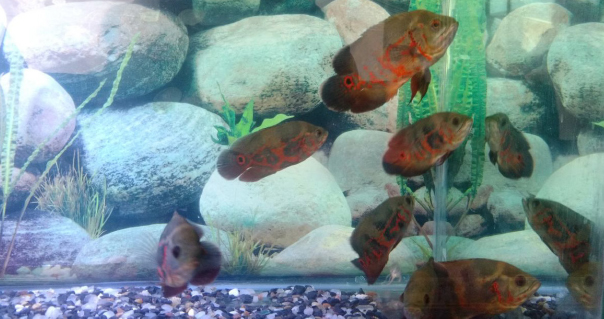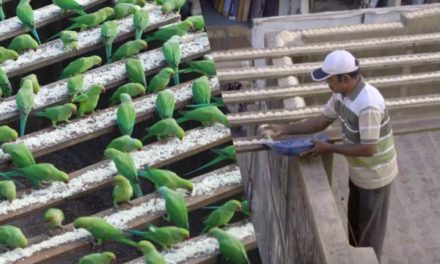
Mathsya Mela 2017 Bangalore – An Exhibition of Ornamental Fish & Accessories

Mathsya Mela 2017 Bangalore – An Exhibition of Ornamental Fish & Accessories
In conversation with Dr. T Mahesh, Deputy Director and Dr. Ramacharya, Joint Director, Dept. of Fisheries, Govt. of Karnataka. at Mathsya Mela 2017 held at the Kanteerava Indoor Stadium, Bangalore.
A&W: What is the purpose of having an ornamental fish exhibition?
Dr. Mahesh: In this age of stress caused by work pressures, traffic, pollution and competition, people need to have ways to relax. Having an aquarium at home is a great stress buster as spending time in front of an aquarium and taking care of it feels very relaxing. It soothes the mind and reduces tensions accumulated during the day.
The purpose of having this exhibition is to commemorate the Department of Fisheries,Govt. of Karnataka as it completes 60 years. The exhibition is being conducted to encourage hobbyists, promote pisciculture,spread knowledge about fisheries, and to generate more revenue for the people involved. It also helps promote knowledge transfer on the best practices, breeding techniques, etc.
A&W: How difficult is it to rear ornamental fish at home?
Dr. Mahesh: It is quite easy to rear fish at home; we train people who are interested in learning how to rear fish. We have a week or fortnight long training programmes in Bhadra project at Shivamogga, Bethamangala at Kolar and at KRS in Mysore. You can contact the department for further details.
A&W: Which are the toughest and best fish for rearing?
Dr. Mahesh: I would say it is the Catla fish also known as the ‘Indian Carp.’ They are easy to breed but tough to rear as survivability is a challenge for the species although they are endemic. These are important freshwater fish species preferred by consumers.
A&W: Which ornamental fish are suitable for Indian climatic condition?
Dr. Mahesh: I think it is ‘Carp’, rather the ‘Gold Carp’. There are different varieties of it such as the ‘Lionhead’, ‘Veiltail’, ‘Black Telescope’,‘Fantail’ which are all adaptable to Indian conditions. Even the ‘Guppies’, ‘Tetras’ as well as ‘Gourami’ adapt and survive easily.
A&W: What are the most popular ornamental fish around the world and in India?
Dr. Mahesh: The fish that are popular in India are ‘Catla’, ‘Rohu’ and ‘Mrigal’ which are crop fish. And among the Ornamental fish it would be the ‘Arowana’, ‘Gold Carp’ commonly known as ‘goldfish’,‘Gouramis’,‘Guppies’, ‘Tetras’, ‘Betta Splendens’ or the ‘Siamese fighter fish’ and ‘Angel Fish’ are also a favourite. The ‘Gold Carp’ & ‘Arowana’ which is known as ‘Vaastu Fish’ nowadays are most popular.
A&W: What are the foods given to the fish, and what vitamins are essential for them?
Dr. Mahesh: The food that is given to the fish must contain balanced nutrients with approximated composition of proteins & vitamins. In their natural habitat, the fish feed on planktons which provide necessary nutrition, and hence there is no need for supplements. But in a controlled environment, we give artificial feed which contain formulated nutrients to mimic nature. A balanced diet ideally consists of 25-30% protein, 3-4% fat, and minute quantities of vitamins for both Ornamental and Crop Fish. Mainly vitamins E & C are essential for reproduction and resistance to infections respectively.
A&W: What are common ailments that the fish suffer from?
Dr. Ramacharya: Viral infections, bacterial infections, fungal infections and worm infestations are common ailments amongst the fish. All these can arise due to poor living conditions such as poor water quality, overcrowding and stress by incompatible species, creating conditions that can lead to destructive outbreaks of infections. They have to be identified and treated before it spreads.
The Dept. of Fisheries, Govt. of Karnataka has established a quarantine facility, the first of its kind in India for ornamental fish at Hesarghatta, near Bengaluru. The fish imported are quarantined and screened for infections and treated if required. This is set to be opened within two months as a central govt. team has visited the facility and suggested improvements to enhance it.When the fish are quarantined, we can analyse if they are healthy or infected, and also whether the fish can adapt to the local conditions. The facility can simulate all aquatic conditions like Marine or fresh water ecosystems, the temperature and even the pH value of water.The Imported fish can be screened properly in the facility to prevent any outbreak of disease and also to ensure their survivability in the long run.
A&W: Where does the Indian market import ornamental fish from?
Dr. Ramacharya: The imports are mainly from South East Asian countries like Thailand, Vietnam,Cambodia and the surrounding countries.They can even be brought in from as far as Australia.
A&W: Which are the most expensive ornamental fish in India?
Dr. Ramacharya: The ‘Arowana’ is one of the costlier fish as they are considered to be the ‘Vaastu Fish’ that bring good fortune to the household.
A&W: What is the market size for Ornamental fish and what is the annual growth rate of the market?
Dr. Ramacharya: The market is essentially scattered and we have to put a proper structure in place to get the exact numbers in the state.
But according to reports the ornamental fish market globally is a multi-billion dollar industry. Since 1985 the value of international trade in exports of ornamental fish has grown at an average rate of approximately 14 % per annum.
Ornamental fish-keeping was initially considered as an attractive hobby practised in the developed countries. But, recently it is gaining impetus in developing countries too, as they now constitute for about two thirds of the global export value .
Overall it is the growing interest in aquarium fish that has resulted in steady increase in aquarium fish trade globally. The whole industry,inclusive of non-exported product, wages, retail sales accessories and fish feed, has been estimated to be worth around US$15 billion.
Around 2000 species and millions of its specimens are traded annually in the ornamental fish market but only around 30-35 species of fresh water fish dominate the industry.
In India the hobby is nearly 70 years old and dates back to the pre-independence era. India’s overall ornamental fish trade was about 1.06 million US$ during the year 2009. The lagoons and coral reefs of Lakshadweep and Minicoy islands, Andaman and Nicobar islands, the Okha -pin tan, the Gulf of Kutch complex, the coast of Kerala, Cape Comorin, the Gulf of Mannar and the Palk bay have an abundanceof highly attractive species of ornamental fish. India has recorded at least 150 commercially important ornamental fish species and trades mainly in indigenous freshwater species collected from rivers.
Prominent among the fresh water Indian ornamental fish are Loaches, Eels, Barbs, Catfish, and Goby . About 90% of ornamental fish is traded from the Kolkata port followed by 8 % from Mumbai and 2 % from Chennai.
However, the new regulations announced by the Environmental Ministry might affect the Rs. 300-crore domestic ornamental fish trade industry which is poised for a phenomenal growth. Its effect will also be felt in the growing export sector which has been marked as an area of focus in the marine sector though India is still a marginal player in the $3.5 billion global trade. India’s ornamental fish export touched Rs 9.5 crore in 2016, marking almost a 40% increase from a year earlier.












